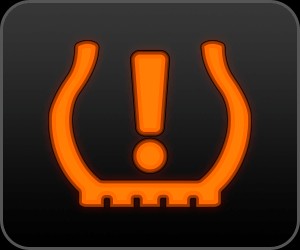It’s a typical driving day when, out of the blue, a light flashes on your car’s dashboard. Among the array of symbols, it’s often hard to recall what each warning light signifies without consulting your vehicle’s manual. Many drivers find themselves in this exact situation. Understanding the meaning behind these warning signals is crucial for every car owner to assess the seriousness of any potential issue. At cars.edu.vn, we aim to clarify the meaning of different car warning lights, helping you stay informed and safe on the road.
One of the frequently encountered, yet sometimes confusing, symbols is the exclamation mark. Often depicted within a horseshoe or a tire-like shape, this symbol is your tire pressure warning light.
Decoding the Exclamation Mark: Your Tire Pressure Light
When you see an exclamation mark symbol illuminate on your dashboard, it’s indicating that one or more of your tires are significantly underinflated. This system, known as the Tire Pressure Monitoring System (TPMS), is designed to alert you to situations where tire pressure falls below a safe level.
Why is Tire Pressure Important?
Maintaining proper tire pressure is crucial for several reasons:
- Safety: Underinflated tires can lead to reduced handling and braking capabilities, increasing the risk of accidents. They also generate more heat, which can cause tire failure, especially at high speeds.
- Fuel Efficiency: Low tire pressure increases rolling resistance, forcing your engine to work harder and consume more fuel.
- Tire Longevity: Driving on underinflated tires causes uneven wear, shortening the lifespan of your tires and requiring premature replacement.
What to Do When the Exclamation Mark Light Comes On
- Stay Calm and Assess: Don’t panic. The light indicates a problem that needs attention, but it doesn’t necessarily mean immediate danger if you react correctly.
- Find a Safe Place to Stop: As soon as it is safe to do so, pull over to the side of the road or a parking area.
- Check Your Tires: Visually inspect your tires. Look for any obvious signs of deflation, damage, or punctures.
- Use a Tire Pressure Gauge: If you have a tire pressure gauge, check the pressure of each tire. Compare the readings to the recommended tire pressure listed on the sticker usually found on your driver’s side doorjamb or in your owner’s manual.
- Inflate Your Tires: If you find a tire is low, inflate it to the recommended pressure using a portable air compressor or by visiting a nearby gas station with an air pump.
- Monitor the Light: After inflating your tires, the warning light should turn off after a short drive. If the light remains on or comes back on shortly after, it could indicate a leak or a more serious issue.
- Seek Professional Service: If the light persists, or if you notice any tire damage, it’s essential to have your tires and TPMS checked by a qualified mechanic. There might be a slow leak, a puncture, or a problem with the TPMS sensor itself.
Beyond the Exclamation Mark: Other Essential Warning Lights
While the exclamation mark for tire pressure is common, there are other crucial warning lights you should be aware of:
ABS Warning Light: Indicated by “ABS” within a circle, this light signals a problem with your Antilock Braking System. Immediate professional inspection is recommended as it affects braking safety.
Engine Temperature Warning Light: Often resembling a thermometer in water, this warns of engine overheating. Pull over safely and allow your engine to cool down before investigating further to prevent serious engine damage.
Lamp Out Warning Light: Symbolized by a sun-like icon, this indicates a malfunctioning exterior light, such as a headlight, taillight, or brake light. Replace the bulb promptly, especially before driving at night, to ensure visibility and legal compliance.
Stay Informed, Drive Safe
Dashboard warning lights are your car’s way of communicating potential issues. Recognizing the exclamation mark as the tire pressure warning light and understanding other symbols can empower you to take timely action, ensuring your safety and maintaining your vehicle’s health. When in doubt, always consult your vehicle’s manual or seek assistance from a certified service professional to address any warning lights promptly.
